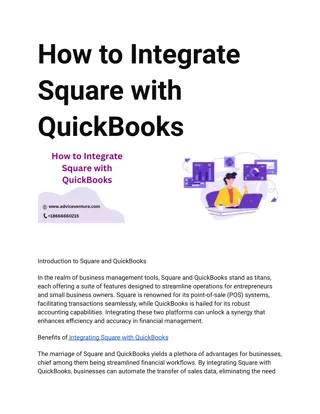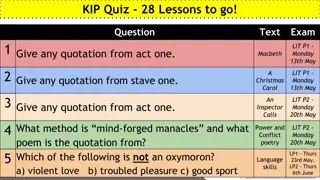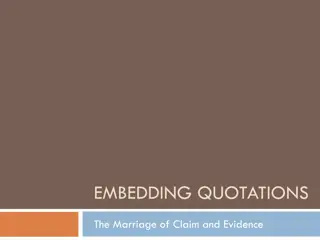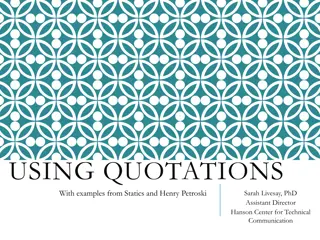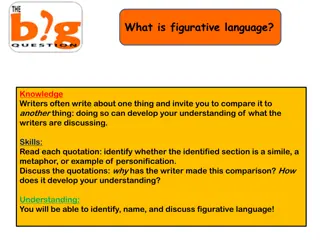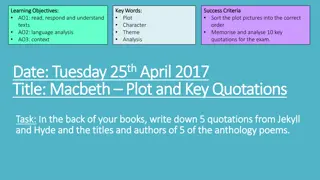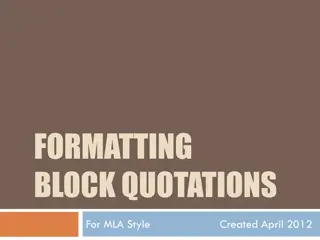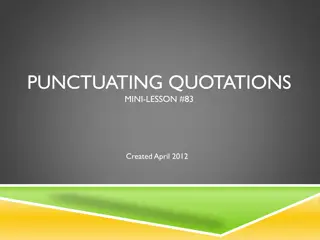Effective Ways to Integrate Quotations in Writing
Integrating quotations in writing is essential for maintaining coherence in your text. Learn how to select relevant quotes, avoid stand-alone quotations, and properly punctuate them. Explore different methods like introducing quotes with complete sentences, using introductory phrases, and more for seamless integration.
Download Presentation

Please find below an Image/Link to download the presentation.
The content on the website is provided AS IS for your information and personal use only. It may not be sold, licensed, or shared on other websites without obtaining consent from the author.If you encounter any issues during the download, it is possible that the publisher has removed the file from their server.
You are allowed to download the files provided on this website for personal or commercial use, subject to the condition that they are used lawfully. All files are the property of their respective owners.
The content on the website is provided AS IS for your information and personal use only. It may not be sold, licensed, or shared on other websites without obtaining consent from the author.
E N D
Presentation Transcript
Brainstorming: Which Quotes To Use? Read the text carefully. Select the main words; seek to understand the text fully; and make personal connections centered around these main words. Take your time. You will not be rushed, so spend plenty of time on this step. Explore several approaches to the topic, and decide which one you could select as the strongest one for you to write about. Write down your ideas. Not only will this help you stay focused, it will help with arranging your paragraphs so that they are smoothly connected.
Integrating Quotations (and Using Proper Punctuation) You should never have a quotation standing alone as a complete sentence. The Guide to Writing compares quotations with helium balloons. We all know what happens when you let go of a helium balloon: it flies away. In a way, the same thing happens when you present a quotation that is standing all by itself in your writing, a quotation that is not "held down" by one of your own sentences. The quotation will seem disconnected from your own thoughts and from the flow of your sentences.
There are at least four ways to integrate quotations.
1. Introduce the quotation with a complete sentence and a colon. This is an easy rule to remember: if you use a complete sentence to introduce a quotation, you need a colon after the sentence. Using a comma in this situation will create a comma splice, one of the serious sentence-boundary errors. : = colon (not ; which is a semi-colon)
1. Introduce the quotation with a complete sentence and a colon. Example: Wetherell ends his story with a hyperbole: "The memory of that lost bass haunted me all summer and haunts me still" (Wetherell 35).
2. Use an introductory or explanatory phrase, but not a complete sentence, separated from the quotation with a comma. You should use a comma to separate your own words from the quotation when your introductory or explanatory phrase ends with a verb such as : says, said, Thinks believes, pondered, recalls, questions, asks
2. Use an introductory or explanatory phrase, but not a complete sentence, separated from the quotation with a comma. You should also use a comma when you introduce a quotation with a phrase such as According to Wetherell.
2. Use an introductory or explanatory phrase, but not a complete sentence, separated from the quotation with a comma. Example: Wetherell recalls, "The only creature that seemed lovelier than a largemouth bass was Sheila Mant (Wetherell 31). Example: According to Wetherell, "[The Mants] appeared to [be] denizens of a brilliant existence " (Wetherell 31).
3. Make the quotation a part of your own sentence without any punctuation between your own words and the words you are quoting by using that . When that is used, "that" replaces the comma which would be necessary without "that" in the sentence.
3. Make the quotation a part of your own sentence without any punctuation between your own words and the words you are quoting by using that . When you begin a sentence with a phrase such as "Wetherell says," you either can add a comma after "says," or you can add the word "that" with no comma.
3. Make the quotation a part of your own sentence without any punctuation between your own words and the words you are quoting by using that Example: Wetherell describes that "the coxswain would curse at them through his megaphone but without effect (Wetherell 31). Example: Wetherell says that [he] would have given anything not to appear dumb in Sheila s eyes (Wetherell 33).
4. Use very short quotations-- only a few words--as part of your own sentence. When you integrate quotations in this way, you do not use any special punctuation. Instead, you should punctuate the sentence just as you would if all of the words were your own except for quotation marks around the quote (of course).
4. Use very short quotations--only a few words--as part of your own sentence. Example: Wetherell describes how he was "torn apart between longings" for "the beat of the river" and for the "casual touchings and grace offered up between Sheila Mant and the largemouth bass that night on the river (Wetherell 35).




